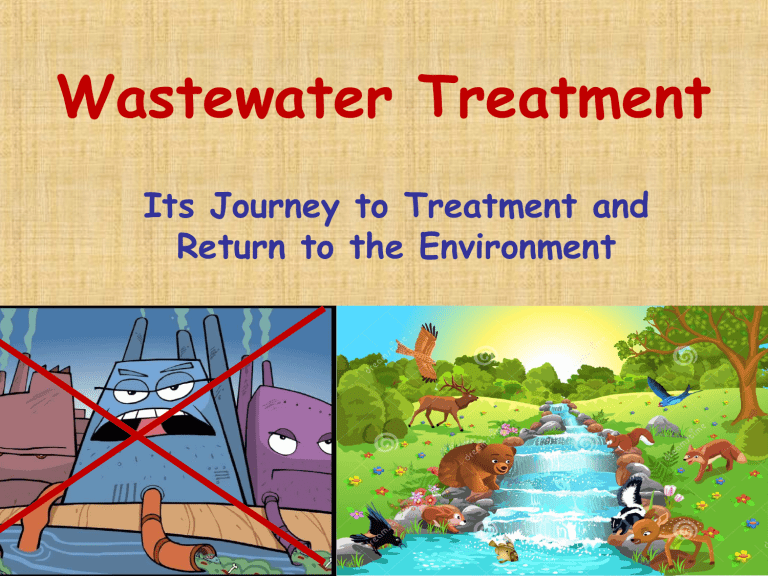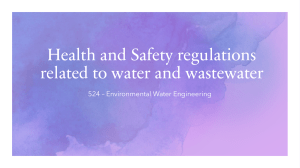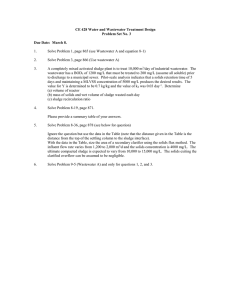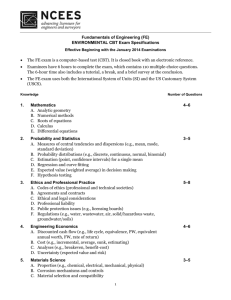wwtppt-161203034016
advertisement

Wastewater Treatment Its Journey to Treatment and Return to the Environment Group Members • • • • Nusrat Bashir Zarnab Sehzad Samra Niaz Sultana Jamil What is Wastewater? • Wastewater is a term that is used to describe waste material that includes industrial liquid waste and sewage waste that is collected in towns and urban areas and treated at urban wastewater treatment plants. Wastewater treatment • A process to convert wastewater which is water no longer needed or suitable for its most recent use - into an effluent that can be either returned to the water cycle with minimal environmental issues or reused. Wastewater Contaminants • • • • Suspended solids Biodegradable organics (e.g., BOD) Pathogenic bacteria Nutrients (N & P) Where does wastewater come from? • Residences ― human and animal excreta and waters used for washing, bathing, and cooking. • Commercial institution • Dairy and industrial establishment ― slaughterhouse waste, dairy waste, tannery wastewater, etc. Where does it all go! Where does the water from the washer go? When you flush the toilet where does the contents go? By gravity flow, the waste is on its way to your local wastewater treatment plant! Why treat wastewater? • Causes a demand for dissolved oxygen (lower DO levels of streams) • Adds nutrients (nitrate and phosphate) to cause excessive growth • Increases suspended solids or sediments in streams (turbidity increase) Objectives of WWT • Reduce organic content i.e., BOD • Removal/reduction of nutrients i.e., N,P • Removal/inactivation of pathogenic microbes Levels of Treatment Primary – removal by physical separation of grit and large objects (material to landfill for disposal) – Sedimentation and screening of large debris Mostly dead microbes Secondary – Biological and chemical treatment – aerobic microbiological process (sludge) organic matter + O2 CO2 + NH3 + H2O aquatic nutrient NH NO 3 3 Treatment stages - Primary treatment • typical materials that are removed during primary treatment include – fats, oils, and greases – sand, gravels and rocks – larger settle-able solids including human waste, and – floating materials Methods used in primary treatment Bar screens Grinding Grit Chamber Sedimentation Tank- primary Settling tank • Chlorination of effluent • • • • Sedimentation Tankprimary Settling tank – Remove grease, oil – Fecal solid settle, floating material rise to the surface – Produce a homologous liquid for later biological treatment – Fecal sludge are pumped to sludge treatment plant Secondary treatment • Biological treatment – activated sludge – trickling filter – oxidation ponds Activated sludge process • • • • • Primary wastewater mixed with bacteria-rich (activated) sludge and air or oxygen is pumped into the mixture Both aerobic and anaerobic bacteria may exist Promotes bacterial growth and decomposition of organic matter BOD removal is approximately 85% Microbial removal by activated sludge • • 80-99% removal of bacteria 90-99% removal of viruses 5 physical components • Aeration tank • oxygen is introduced into the system • Aeration source • ensure that adequate oxygen is fed into the tank • provided pure oxygen or compressed air • Secondary clarifiers • activated-sludge solids separate from the surrounding wastewater • Activated sludge outflow line • Pump activated sludge back to the aeration tank • Effluent outflow line • discharged effluent into bay or tertiary treatment plant Aeration and rapid mixing Settling collects sludge on bottom From primary process To tertiary process air diffuser Secondary process Trickling filters • Trickling filters are beds made of coke (carbonized coal), limestone chips or specially fabricated plastic media • Optimize their thickness by insect or worm grazing • The primary wastewater is sprayed over the filter and microbes decompose organic material aerobically. • Low pathogen removal - Bacteria, 20-90% - Viruses, 50-90% - Giardia cysts, 70-90% Tric king filte rs Stabilization or oxidation ponds • • • • • Oxidation ponds are a few meters deep, and up to a hectare in size. They are low cost with retention times of 1 to 4 weeks. Odor and mosquitoes can be a problem Pathogen removal: - Bacteria, 90-99% - Virus, 90-99% - Protozoa, 67-99% Mechanisms include the long detention time, high pH (1010.5) generated by photosynthesis, predation, sunlight, temperature Continued… Stabilization ponds are the preferred wastewater treatment process in developing countries due to low cost, low maintenance. This is balanced by larger land requirement. When the treatment is done… • Effluent back to stream after – a final carbon filtration and – chlorination/de-chlorination • Sludge – very nutrient rich – applied directly to land as fertilizer – incinerated (good fuel after drying) – composted Sludge Treatment Processes Thickening (water removal) Digestion (pathogen inactivation and odor control) Conditioning (improved dewatering with alum and high temp, 175-230o C) Dewatering (pathogen inactivation and odor control) Incineration (volume and weight reduction) Final disposal Wastewater Treatment Alternatives • Septic Tanks • Constructed Wetlands • Composting Questions



